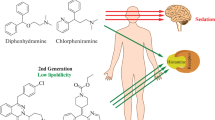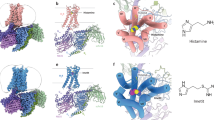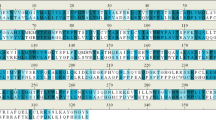Abstract
Histamine-1 receptor (H1R) belongs to the family of rhodopsin-like G-protein-coupled receptors expressed in cells that mediates allergies and other pathophysiological diseases. For alleviation of allergic symptoms, H1R antagonists are therapeutic drugs; of which the most frequently prescribed are second generation drugs, such as; Cetirizine, Loratadine, Hydroxyzine, Desloratadine, Bepotastine, Acrivastine and Rupatadine. To understand their potency, binding affinity and interaction; we have employed molecular docking and quantum chemical study such as; Induced-fit docking and calculation of quantum chemical descriptors. This study also introduces the binding site characterization of H1R, with its known antagonists and Curcumin (our proposed alternative H1R antagonist); useful for future drug target site. The interactive binding site residues of H1R are found to be; Lys-191, Tyr-108, Asp-107, Tyr-100, Lys-179, Lys-191, Thr-194, Trp-428, Phe-432, Tyr-458, Hie-450, with most of these shown to be inhibited by naturally-occurring compound curcumin. Amongst the FDA approved drugs, Hydroxyzine showed best ligand binding affinity, calculated as − 141.491 kcal/mol and naturally occurring compound, Curcumin showed binding affinity of − 87.046 kcal/mol. The known antagonists of H1R has been used for hypothesizing curcumin as naturally occurring lead compound for the target using accurate molecular docking simulation study. Though the pharmacological action of known inhibitor is already established, they could differ from their reactivity, which we have also focused in our study for predicting drug reactivity.




Similar content being viewed by others
References
Aggarwal BB, Sundaram C, Malani N, Ichikawa H (2007) Curcumin: the Indian solid gold. Adv Exp Med Biol 595:1–75. https://doi.org/10.1007/978-0-387-46401-5_1
Antony S, Kuttan R, Kuttan G (1999) Immunomodulatory activity of curcumin. Immunol Investig 28:291–303
Arima M et al (1999) Expression of interleukin-16 by human epithelial cells: inhibition by dexamethasone. Am J Respir Cell Mol Biol 21:684–692
Bakker RA, Schoonus SB, Smit MJ, Timmerman H, Leurs R (2001) Histamine H1-receptor activation of nuclear factor-κB: roles for Gβγ-and Gαq/11-subunits in constitutive and agonist-mediated signaling. Mol Pharmacol 60:1133–1142
Bakker RA, Casarosa P, Timmerman H, Smit MJ, Leurs R (2004) Constitutively active Gq/11-coupled receptors enable signaling by co-expressed Gi/o-coupled receptors. J Biol Chem 279:5152–5161
Balasubramanyam M, Koteswari AA, Kumar RS, Monickaraj SF, Maheswari JU, Mohan V (2003) Curcumin-induced inhibition of cellular reactive oxygen species generation: novel therapeutic implications. J Biosci 28:715–721
Berman HM et al (2000) The protein data bank. Nucleic Acids Res 28:235–242
Brown RE, Sergeeva OA, Eriksson KS, Haas HL (2002) Convergent excitation of dorsal raphe serotonin neurons by multiple arousal systems (orexin/hypocretin, histamine and noradrenaline). J Neurosci 22:8850–8859
Caron G, Delneste Y, Roelandts E, Duez C, Herbault N, Magistrelli G, Bonnefoy J-Y, Pestel J, Jeannin P (2001) Histamine induces CD86 expression and chemokine production by Human Immature Dendritic Cells. J Immunol 166(10):6000–6006
Chandra D, Gupta SJ (1972) Anti-inflammatory and anti-arthritic activity of volatile oil of Curcuma longa (Haldi). Indian J Med Res 60:138
Chung S-H, Choi SH, Choi JA, Chuck RS, Joo C-K (2012) Curcumin suppresses ovalbumin-induced allergic conjunctivitis. Mol Vis 18:1966–1972
Conen S et al (2013) The role of P-glycoprotein in CNS antihistamine effects. Psychopharmacology 229:9–19
de Benedictis FM, Bush AJA, Medicine CC (2012) Corticosteroids in respiratory diseases in children. Am J Respir Crit Care Med 185:12–23
Easton RE, Giesen DJ, Welch A, Cramer CJ, Truhlar DG (1996) The MIDI! basis set for quantum mechanical calculations of molecular geometries and partial charges. Theor Chim Acta 93:281–301. https://doi.org/10.1007/bf01127507
Elphick HE, Southern KW (2012) Antifungal therapies for allergic bronchopulmonary aspergillosis in people with cystic fibrosis. Cochrane Database Syst Rev. https://doi.org/10.1002/14651858.cd002204.pub2
Frisch MJ, Trucks GW, Schlegel HB, Scuseria GE, Robb MA, Cheeseman JR, Scalmani G, Barone V, Petersson GA, Nakatsuji H, Li X, Caricato M, Marenich AV, Bloino J, Janesko BG, Gomperts R, Mennucci B, Hratchian HP, Ortiz JV, Izmaylov AF, Sonnenberg JL, Williams-Young D, Ding F, Lipparini F, Egidi F, Goings J, Peng B, Petrone A, Henderson T, Ranasinghe D, Zakrzewski VG, Gao J, Rega N, Zheng G, Liang W, Hada M, Ehara M, Toyota K, Fukuda R, Hasegawa J, Ishida M, Nakajima T, Honda Y, Kitao O, Nakai H, Vreven T, Throssell K, Montgomery Jr JA, Peralta JE, Ogliaro F, Bearpark MJ, Heyd JJ, Brothers EN, Kudin KN, Staroverov VN, Keith TA, Kobayashi R, Normand J, Raghavachari K, Rendell AP, Burant JC, Iyengar SS, Tomasi J, Cossi M, Millam JM, Klene M, Adamo C, Cammi R, Ochterski JW, Martin RL, Morokuma K, Farkas O, Foresman JB, Fox DJ (2016) Gaussian 16 Rev. B.01. Gaussian, Inc., Wallingford CT
Fujikura T, Shimosawa T, Yakuo I (2001) Regulatory effect of histamine H1 receptor antagonist on the expression of messenger RNA encoding CC chemokines in the human nasal mucosa. J Allergy Clin Immunol 107:123–128
Gilani AH, Shah AJ, Ghayur MN, Majeed KJLS (2005) Pharmacological basis for the use of turmeric in gastrointestinal and respiratory disorders. Life Sci 76:3089–3105
Giustizieri ML, Albanesi C, Fluhr J, Gisondi P, Norgauer J, Girolomoni G (2004) H1 histamine receptor mediates inflammatory responses in human keratinocytes. J Allergy Clin Immunol 114:1176–1182. https://doi.org/10.1016/j.jaci.2004.07.054
Harder E et al (2016) OPLS3: a force field providing broad coverage of drug-like small molecules and proteins. J Chem Theory Comput 12:281–296. https://doi.org/10.1021/acs.jctc.5b00864
Hill S et al (1997) International Union of Pharmacology. XIII. Classification of histamine receptors. Pharmacol Rev 49:253–278
Hoque MM, Halim MA, Sarwar MG, Khan MW (2015) Palladium-catalyzed cyclization of 2-alkynyl-N-ethanoyl anilines to indoles: synthesis, structural, spectroscopic, and mechanistic study. J Phys Org Chem 28:732–742. https://doi.org/10.1002/poc.3477
Jeannin P et al (1994) Histamine induces interleukin-8 secretion by endothelial cells. Blood 84:2229–2233
Jutel M, Watanabe T, Akdis M, Blaser K, Akdis CA (2002) Immune regulation by histamine. Curr Opin Immunol 14:735–740. https://doi.org/10.1016/s0952-7915(02)00395-3
Kanda N, Watanabe S (2004) Histamine enhances the production of granulocyte-macrophage colony-stimulating factor via protein kinase Cα and extracellular signal-regulated kinase in human keratinocytes. J Investig 122:863–872
Kim SH, Kwon JE, Kim H-BJA (2013) Successful treatment of steroid-dependent eosinophilic cellulitis with cyclosporine. Allergy Asthma Immunol Res 5:62–64
Koe XF, Tengku Muhammad TS, Chong AS-C, Wahab HA, Tan ML (2014) Cytochrome P450 induction properties of food and herbal-derived compounds using a novel multiplex RT-qPCR in vitro assay, a drug-food interaction prediction tool. Food Sci Nutr 2:500–520. https://doi.org/10.1002/fsn3.122
Lee C, Yang W, Parr RG (1988) Development of the Colle–Salvetti correlation-energy formula into a functional of the electron density. Phys Rev B Condens Matter 37:785–789
Lee JH et al (2008) Curcumin, a constituent of curry, suppresses IgE-mediated allergic response and mast cell activation at the level of Syk. J Allergy Clin Immunol 121:1225–1231. https://doi.org/10.1016/j.jaci.2007.12.1160
Li J, Abel R, Zhu K, Cao Y, Zhao S, Friesner RA (2011) The VSGB 2.0 model: a next generation energy model for high resolution protein structure modeling. Proteins 79:2794–2812. https://doi.org/10.1002/prot.23106
Liu X et al (2013) In silico prediction of cytochrome P450-mediated site of metabolism (SOM). Protein Pept Lett 20:279–289
Lovell SC et al (2003) Structure validation by Calpha geometry: phi, psi and Cbeta deviation. Proteins 50:437–450. https://doi.org/10.1002/prot.10286
Lutomski J, Kedzia B, Debska W (1974) Effect of an alcohol extract and of active ingredients from Curcuma longa on bacteria and fungi (author’s transl). Planta Med 26:9–19. https://doi.org/10.1055/s-0028-1097963
Ma RZ et al (2002) Identification of Bphs, an autoimmune disease locus, as histamine receptor H1. Science 297:620–623
Ma C, Ma Z, Fu Q, Ma S (2013) Curcumin attenuates allergic airway inflammation by regulation of CD4 + CD25 + regulatory T cells (Tregs)/Th17 balance in ovalbumin-sensitized mice. Fitoterapia 87:57–64. https://doi.org/10.1016/j.fitote.2013.02.014
Madhavi Sastry G, Adzhigirey M, Day T, Annabhimoju R, Sherman W (2013) Protein and ligand preparation: parameters, protocols, and influence on virtual screening enrichments. J Comput Mol Des 27:221–234. https://doi.org/10.1007/s10822-013-9644-8
Matsubara M, Tamura T, Ohmori K, Hasegawa K (2005) Histamine H1 receptor antagonist blocks histamine-induced proinflammatory cytokine production through inhibition of Ca2+-dependent protein kinase C, Raf/MEK/ERK and IKK/IκB/NF-κB signal cascades. Biochem Pharmacol 69(3):433–449
Musio S et al (2006) A key regulatory role for histamine in experimental autoimmune encephalomyelitis: disease exacerbation in histidine decarboxylase-deficient mice. J Immunol 176:17–26
Oh S-W, Cha J-Y, Jung J-E, Chang B-C, Kwon H-J, Lee B-R, Kim D-Y (2011) Curcumin attenuates allergic airway inflammation and hyper-responsiveness in mice through NF-κB inhibition. J Ethnopharmacol 136:414–421. https://doi.org/10.1016/j.jep.2010.07.026
Parr RG, Zhou Z (1993) Absolute hardness: unifying concept for identifying shells and subshells in nuclei, atoms, molecules, and metallic clusters. Acc Chem Res 26:256–258. https://doi.org/10.1021/ar00029a005
Pedotti R, De Voss JJ, Steinman L, Galli SJ (2003) Involvement of both ‘allergic’and ‘autoimmune’mechanisms in EAE, MS and other autoimmune diseases. Trends Immunol 24:479–484
Rajakrishnan V, Viswanathan P, Rajasekharan K, Menon VP (1999) Neuroprotective role of curcumin from Curcuma longa on ethanol-induced brain damage. Phytother Res Int J Devot Pharmacol Toxicol Eval Nat Prod Deriv 13:571–574
Ringman JM, Frautschy SA, Cole GM, Masterman DL, Cummings JL (2005) A potential role of the curry spice curcumin in Alzheimer’s disease. Curr Alzheimer Res 2:131–136
Rydberg P, Olsen L (2011) Ligand-based site of metabolism prediction for cytochrome P450 2D6. ACS Med Chem Lett 3:69–73. https://doi.org/10.1021/ml200246f
Schaefer U, Schmitz V, Schneider A, Neugebauer E (1999) Histamine induced homologous and heterologous regulation of histamine receptor subtype mRNA expression in cultured endothelial cells. Shock 12:309–315
Shelley JC, Cholleti A, Frye LL, Greenwood JR, Timlin MR, Uchimaya M (2007) Epik: a software program for pKaprediction and protonation state generation for drug-like molecules. J Comput Aided Mol 21:681–691. https://doi.org/10.1007/s10822-007-9133-z
Sherman W, Day T, Jacobson MP, Friesner RA, Farid R (2006) Novel procedure for modeling ligand/receptor induced fit effects. J Med Chem 49:534–553. https://doi.org/10.1021/jm050540c
Srinivasan K (1953) A chromatographic study of the curcuminoids in Curcuma longa L. J Pharm Pharmacol 5:448–457
Tarnasky P, Van JAP (1990) Antihistamine therapy in allergic rhinitis. J Fam Pract 30:71–80
Thakare VN, Osama MM, Naik SR (2013) Therapeutic potential of curcumin in experimentally induced allergic rhinitis in guinea pigs. Int Immunopharmacol 17:18–25. https://doi.org/10.1016/j.intimp.2013.04.025
Thompson DA, Tan BB (2006) Tetrahydracurcumin-related allergic contact dermatitis. Contact Dermat 55:254–255. https://doi.org/10.1111/j.1600-0536.2006.00857.x
Toda S, Miyase T, Arichi H, Tanizawa H, Takino YJC, Bulletin P (1985) Natural antioxidants. III. Antioxidative components isolated from rhizome of Curcuma longa L. Chem Pharm Bull 33:1725–1728
Venter C, Pereira B, Voigt K, Grundy J, Clayton CB, Higgins B, Arshad SH, Dean T (2008) Prevalence and cumulative incidence of food hypersensitivity in the first 3 years of life. Allergy 63:354–359
Wang E-J, Casciano CN, Clement RP, Johnson WW (2001) Evaluation of the interaction of loratadine and desloratadine with P-glycoprotein. Drug Metab Dispos 29:1080–1083
White MV (1990) The role of histamine in allergic diseases. J Allergy Clin Immunol 86:599–605. https://doi.org/10.1016/S0091-6749(05)80223-4
Wishart DS et al (2018) DrugBank 5.0: a major update to the DrugBank database for 2018. Nucleic Acids Res 46:D1074–D1082. https://doi.org/10.1093/nar/gkx1037
Wong R, Wong M, Robinson PD, Fitzgerald DA (2013) Omalizumab in the management of steroid dependent allergic bronchopulmonary aspergillosis (ABPA) complicating cystic fibrosis. Paediatr Respir Rev 14:22–24
Acknowledgements
We would like to express our deepest gratitude and thanks to Allah, our parents, our families, our teachers and all those who’ve helped and supported us along the way.
Funding
The authors received no funding from an external source.
Author information
Authors and Affiliations
Corresponding author
Ethics declarations
Conflict of interest
The authors declare that they have no conflict of interest.
Ethics approval
None.
Additional information
Publisher's Note
Springer Nature remains neutral with regard to jurisdictional claims in published maps and institutional affiliations.
Electronic supplementary material
Below is the link to the electronic supplementary material.
Rights and permissions
About this article
Cite this article
Riza, Y.M., Parves, M.R., Tithi, F.A. et al. Quantum chemical calculation and binding modes of H1R; a combined study of molecular docking and DFT for suggesting therapeutically potent H1R antagonist. In Silico Pharmacol. 7, 1 (2019). https://doi.org/10.1007/s40203-019-0050-3
Received:
Accepted:
Published:
DOI: https://doi.org/10.1007/s40203-019-0050-3




